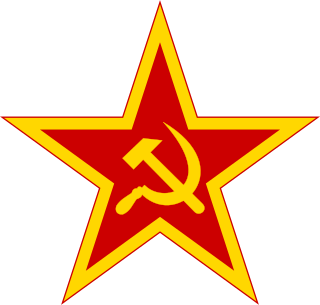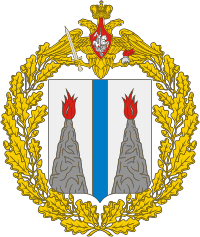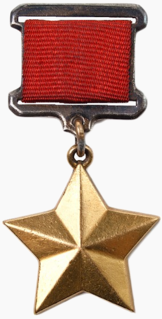
The 8th Guards Order of Lenin Combined Arms Army is an army of the Russian Ground Forces, headquartered in Novocherkassk, Rostov Oblast, within Russia′s Southern Military District, that was reinstated in 2017 as a successor to the 8th Guards Army of the Soviet Union's Red Army, which was formed during World War II and was disbanded in 1998 after being downsized into a corps.

The involvement of the Soviet 14th Guards Army in the War of Transnistria was extensive and contributed to the outcome, which left the Pridnestrovian Moldavian Republic (PMR) with de facto independence from the Republic of Moldova.
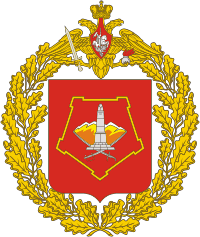
The Volga–Ural Military District was a military district of the Russian Ground Forces, formed on 1 September 2001 by the amalgamation of the Volga Military District and the Ural Military District. The headquarters of the Ural Military District, located at Yekaterinburg became the new headquarters of the merged district. In 2010 the District was merged with part of the Siberian Military District to form the new Central Military District.
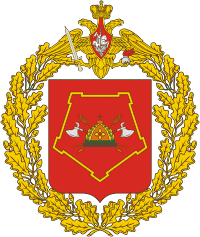
The Siberian Military District was a Military district of the Russian Ground Forces. The district was originally formed as a military district of the Russian Empire in 1864. In 1924 it was reformed in the Red Army. After the end of World War II the district was split into the Western and Eastern Siberian Military Districts. In 1956 the district was reformed. In 2010 it was divided between the two newly formed Central and Eastern Military Districts.
The 6th Army was a field army of the Soviet Red Army formed four times during World War II and active with the Russian Ground Forces until 1998. It appears to have been reformed in 2010.

The Transcaucasian Military District, a military district of the Soviet Armed Forces, traces its history to May 1921 and the incorporation of Armenia, Azerbaijan, and Georgia into the Soviet Union. It was disbanded by being redesignated as a Group of Forces in the early 1990s after the Soviet Union collapse. The military district formed as a basis of the modern day armed forces of Armenia, Azerbaijan and Georgia.

The 35th Combined Arms Red Banner Army is a field army of the Russian Ground Forces. The army was first formed in July 1941 with the Far Eastern Front. After spending most of World War II guarding the border in Primorsky Krai, the army fought in the Soviet invasion of Manchuria in August 1945, and was disbanded shortly after the end of the war. Reformed at Belogorsk when Sino-Soviet tensions rose in the late 1960s in the Far East, the army became part of the Eastern Military District in 2010.
The 85th Leningrad-Pavlovsk Red Banner Motor Rifle Division was an infantry division of the Soviet Red Army converted to a motorised formation in 1957. It was part of the Russian Ground Forces until it was reorganised as a motor rifle brigade in 2009.
The 20th Guards Combined Arms Army is a field army. In 1991, after the dissolution of the Soviet Union, the army became part of the Russian Ground Forces.
The 15th Army was a field army of the Soviet Red Army during the Second World War.
The 43rd Rifle Division was a formation of the Red Army, which took part in the Second World War, known to the Soviets as the "Great Patriotic War".
The 372nd Rifle Red Banner Novgorod Division was a division of the Red Army during the Second World War.

The 32nd Army Corps was an army corps of the Soviet Ground Forces and then the Ukrainian Ground Forces. Its Military Unit Number was a/h 44 690, and from 1994 – a/h A-1916.
The 79th Motor Rifle Division was a motorized infantry division of the Soviet Army. It was converted from the 79th Rifle Division in 1957 and inherited the honorific "Sakhalin". The division was awarded the Order of the Red Banner. The 79th Rifle Division fought in the Invasion of South Sakhalin in 1945 and was based at Leonidovo for most of its career.
The 46th Nizhnedneprovskaya Rocket Division was a division of the Soviet Strategic Rocket Forces, active from 1961–62 to 1992 under the Soviet Union, and from 1992 to 2002 as part of Ukraine. The division traced its history back to the 188th Rifle Division, formed in Kaunas in spring 1941. The division fought in the Battle of the Dnieper, for which it was awarded the honorific "Lower Dnieper". After the Jassy–Kishinev Offensive it garrisoned Sliven in Bulgaria. At some point it moved to Pervomaisk in Ukraine and became the 20th Rifle Division in 1955. In 1957, it became the 93rd Motor Rifle Division and was disbanded in 1959. In 1960, the 29th Rocket Brigade was formed in Pervomaisk and became the 46th Rocket Division in 1960. The 46th Rocket Division inherited the honors and awards of the 188th Rifle Division. After the dissolution of the Soviet Union, the division became part of Ukrainian military and was disbanded by 2002.
The 89th Motor Rifle Division was a motor rifle division of the Soviet Army, formed twice. The division was first formed in 1957 from the 14th Mechanized Division, which was the former 284th Rifle Division. In 1966, it was reformed as a mobilization division. In 1987, it became a territorial training center and a storage base soon after. It was disbanded in 1996. The unit was based at Tambov.
The 68th Army Corps is an army corps of the Russian Ground Forces' Eastern Military District, stationed in Sakhalin and the Kuril Islands, with its headquarters at Yuzhno-Sakhalinsk. The corps was first formed in 1993 from the 51st Army and disbanded in 2010. It was reformed in 2014.
The 69th Covering Brigade is a unique border protection brigade of the Russian Ground Forces, stationed at Babstovo and part of the 35th Army.

